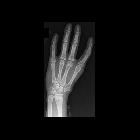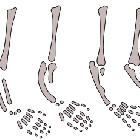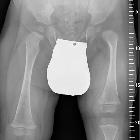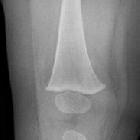radial ray anomaly

A novel
malformation complex of bilateral and symmetric preaxial radial ray-thumb aplasia and lower limb defects with minimal facial dysmorphic features: a case report and literature review. Anteroposterior radiograph of the upper limbs after the reconstruction showed profound radial aplasia, metaphyseal cupping associated with hypoplastic/defective ossification of the carpal bones. Pseudoepiphyses with proximally situated newly reconstructed thumb. The patient had reconstruction of the thumbs with pollizisation of the second finger. This means a rotation-osteotomy of the second finger to the thumb position with reconstruction of the commissural between the new reconstructed thumbs and the second finger, which was originally the third finger.

A rare
association of crossed fused renal ectopia. AP radiograph of the upper limb showing absent radius with radially deviated hand.

Prenatal
sonographic diagnosis of fetal valproate syndrome: a case report. a The neonate’s physical examination reveal bend and contracture of right wrist joint. b A right radial ray defect is observed on this x-ray (arrow)

Radial ray
anomaly • Radial ray deficiency - Ganzer Fall bei Radiopaedia

Radial ray
anomaly • Radial ray deficiency in Fanconi anemia - Ganzer Fall bei Radiopaedia

Radial ray
anomaly • Radial ray anomaly (type IV) - Ganzer Fall bei Radiopaedia

Radial ray
anomaly • Radial ray anomaly - Ganzer Fall bei Radiopaedia

Radial ray
anomaly • Radial ray anomaly - Ganzer Fall bei Radiopaedia

Holt-Oram
syndrome • Holt-Oram syndrome - Ganzer Fall bei Radiopaedia

Teenager with
imperforate anus at birth: The diagnosis was VACTERL association with radial ray hypoplasia.
Radial ray anomalies comprise of a large spectrum of upper limb anomalies which range from partial (radial hypoplasia) to a complete (radial aplasia) deficiency of the radius with or without accompanying deficiency of the thumb bones.
Pathology
Associations
They can be associated with a number of associations which include:
- Aase syndrome
- amniotic band syndrome
- Cornelia de Lange syndrome (CdLS)
- Duane radial ray syndrome (DRRS)
- Fanconi anemia
- Holt-Oram syndrome
- Nager syndrome
- omphalocoele-radial ray (ORR) complex
- Rothmund-Thomson syndrome (RTS)
- in utero teratogen exposure
- valproic acid: valproate embryopathy
- thalidomide: thalidomide embryopathy
- TAR syndrome: thrombocytopenia, absent radius syndrome
- trisomy 18
- VACTERL association
Subtypes
Radial ray anomalies can be classified into four main subtypes depending upon the extent of severity:
- type I: radius is slightly (>2 mm) short and the hand bends sideways at the wrist (often associated with a hypoplastic thumb); proximal radius usually unaffected
- type II: the radius bone is very short and the ulna curves sideways and supports the wrist poorly
- type III: partial absence of radius
- type IV: complete absence of radius
Radiographic features
Antenatal ultrasound
May show absent of hypoplasia of the radius (depending on type) with hand often in medial rotation
Plain radiograph
Allows direct visualization of anatomy but is usually performed postnatally.
Siehe auch:
- Amniotisches-Band-Syndrom
- VACTERL-Assoziation
- Trisomie 18
- Fetales Valproat-Syndrom
- Radiusaplasie
- Tibiale Hemimelie
- Thalidomid-Embryopathie
- Cornelia-de-Lange-Syndrom
- Fanconi-Anämie
- Fibulare Hemimelie
- Proximaler Femurdefekt
- Rothmund-Thomson syndrome
- ulnare Klumphand
- Holt-Oram-Syndrom
- Thrombozytopenie-Radiusaplasie-Syndrom
- Daumenaplasie
- Aase-Smith-Syndrom
- OFM Nager-Syndrom
- Klumphand
- Radialstrahldefekte bei Fanconi-Anämie
- Okihiro-Syndrom
und weiter:

 Assoziationen und Differentialdiagnosen zu Radialstrahldefekte:
Assoziationen und Differentialdiagnosen zu Radialstrahldefekte:













